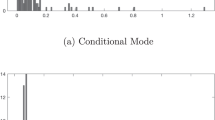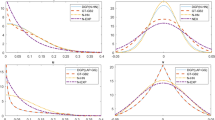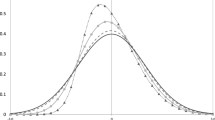Abstract
We present a new, single-parameter distributional specification for the one-sided error components in single-tier and two-tier stochastic frontier models. The distribution has its mode away from zero, and can represent cases where the most likely outcome is non-zero inefficiency. We present the necessary formulas for estimating production, cost and two-tier stochastic frontier models in logarithmic form. We pay particular attention to the use of the conditional mode as a predictor of individual inefficiency. We use simulations to assess the performance of existing models when the data include an inefficiency term with non-zero mode, and we also contrast the conditional mode to the conditional expectation as measures of individual (in)efficiency.
Similar content being viewed by others
Notes
This approach was first presented in Materov (1981), that is written in Russian and it is a good example of the universality of the language of mathematics.
The under-estimation of technical efficiency here depends on the determinants of inefficiency being positive variables, and they usually are.
The authors proved this for the variable in levels. Using intuition but also the formal results in Egozcue (2015), it also holds for \(E(\exp \{-u\}| \varepsilon )\).
But it is not immediate to translate it in intuitive terms, because, here, improving cost efficiency means reducing the denominator of the ratio. In fact the value \(1-CE=1-\exp \{-w\}\) is more naturally communicated, being the proportional reduction in costs required to attain full cost efficiency. So if, say, CE = 0.8, we have to reduce costs by 1 − 0.8 = 20% to reach the frontier, holding output constant.
This is not the same as “changing ventile” which could happen if a firm moves from, say, the 5th percentile to the 6th.
References
Aigner DJ, Lovell CAK, Schmidt P (1977) Formulation and estimation of stochastic frontier production function models. J Econom 6:21–37
Azzalini A (1985) A class of distributions which includes the normal ones. Scand J Stat 12:171–178
Battese GE, Coelli TJ (1988) Prediction of firm-level technical efficiencies with a generalized frontier production function and panel data. J Econom 38:387–399
Cai J, Feng Q, Horrace WC, Wu GL (2020) Wrong skewness and finite sample correction in parametric stochastic frontier models. Empir Econ Forthcom
Egozcue M (2015) Some covariance inequalities for non-monotonic functions with applications to mean-variance indifference curves and bank hedging. Cogent Math 2:991082
Erdelyi A, Magnus W, Oberhettinger F, Tricomi FG (eds) (1954) Tables of Integral Transforms: Vol.1. New York, McGraw-Hill
Gradshteyn IS, Ryzhik IM (2007) Tables of integrals, series and functions (7th ed). Burlington MA USA, Academic Press
Greene W (1980) On the estimation of a flexible frontier production model. J Econom 13:101–115
Greene W (1990) A gamma-distributed stochastic frontier model. J Econom 46:141–163
Grushka E (1972) Characterization of exponentially modified gaussian peaks in chromatography. Anal Chem 44:1733–1738
Gupta RD, Kundu D (1999) Generalized Exponential distributions. Austral N. Z. J Stat 41:173–188
Hafner CM, Manner H, Simar L (2018) The wrong skewness problem in stochastic frontier models: a new approach. Econom Rev 37:380–400
Jondrow J, Lovell CK, Materov I, Schmidt P (1982) On the estimation of technical inefficiency in the stochastic frontier production function model. J Econom 19:233–238
Kumbhakar SC, Lovell C (2000) Stochastic Frontier Analysis. Cambridge, Cambridge University Press
Materov I (1981) On full identification of the stochastic production frontier model. Ekonomika i matematicheskie metody 17:784–788
Meeusen W, van~den Broeck J (1977) Efficiency estimation from Cobb-Douglas production functions with composed error. Int Econ Rev 18:435–444
Ondrich J, Ruggiero J (2001) Efficiency measurement in the stochastic frontier model. Eur J Oper Res 129:434–442
Papadopoulos A (2018) The two-tier stochastic frontier framework: Theory and applications, models and tools. PhD Thesis. Athens Greece, Athens University of Economics and Business
Papadopoulos A (2020a) Accounting for endogeneity in regression models using Copulas: a step-by-step guide for empirical studies. Manuscript. Athens University of Economics and Business
Papadopoulos A (2020b) Measuring the effect of management on production: a two-tier stochastic frontier approach. Empir Econ. https://doi.org/10.1007/s00181-020-01946-9
Papadopoulos A, Parmeter CF (2020) Quasi-maximum likelihood estimation for the stochastic frontier model. Manuscript. Athens University of Economics and Business
Papadopoulos A, Parmeter CF (2021) Type II failure and specification testing for the stochastic frontier model. Eur J Oper Res. https://doi.org/10.1016/j.ejor.2020.12.065
Papadopoulos A (2020c) The two-tier stochastic frontier framework (2TSF): measuring frontiers wherever they may exist. In: Parmeter CF, Sickles R (eds) Advances in Efficiency and Productivity Analysis, Cham Switzerland, Springer
Parmeter CF, Kumbhakar SC (2014) Efficiency analysis: a primer on recent advances. Found Trends Econom 7:191–385
Parmeter CF (2018) Estimation of the two-tiered stochastic frontier model with the scaling property. J Product Anal 49:37–47
Polachek SW, Yoon BJ (1987) A two-tiered earnings frontier estimation of employer and employee information in the labor market. Rev Econ Stat 69:296–302
Ritter C, Simar L (1997) Pitfalls of normal-gamma stochastic frontier models. J Product Anal 8:167–182
Sickles R, Zelenyuk V (2019) Measurement of productivity and efficiency. Cambridge, Cambridge University Press
Simar L, Wilson PW (2009) Inferences from cross-sectional, stochastic frontier models. Econom Rev 29:62–98
Stead AD, Wheat P, Greene WH (2019) Distributional forms in stochastic frontier analysis. In: Ten Raa T, Greene WH (eds) The Palgrave Handbook of Economic Performance Analysis, Cham, Swizerland, Palgrave Macmillan
Stevenson R (1980) Likelihood functions for generalized stochastic frontier estimation. J Econom 13:57–66
Tran KC, Tsionas EG (2015) Endogeneity in stochastic frontier models: copula approach without external instruments. Econ Lett 133:85–88
Wang JH, Schmidt P (2002) One-step and two-step estimation of the effects of exogenous variables on technical efficiency levels. J Product Anal 18:129–144
Williams D (1991) Probability with martingales. Cambridge, Cambdridge Univerity Press
Author information
Authors and Affiliations
Corresponding author
Ethics declarations
Conflict of interest
The author declares that he has no conflict of interest.
Additional information
Publisher’s note Springer Nature remains neutral with regard to jurisdictional claims in published maps and institutional affiliations.
Appendix
Appendix
1.1 The conditional expectation in the NGE production frontier
In the production SF model we want to compute
where we have used the additive form of the GE density, eq. (2). Decomposing the integrands,
Combining formulas from Gradshteyn and Ryzhik (2007) and Erdelyi et al. (1954), we have (for a > 0),
For both integrals, we have the common mapping
Moreover we have, using indices 1 and 2 for the two integrands,
Exploiting these results to make some initial simplifications we can write
Now,
Also,
Combining all, we arrive at
1.2 The conditional mode in the NGE production frontier
We want to maximize the conditional density in eq. (9) with respect to q. Ignoring the terms that do not include q, the derivative we want to set equal to zero is
Using the property of the standard Normal density \(\phi ^{\prime} (z)=-z\phi (z)\) we obtain
Setting this expression equal to zero is equivalent to setting the expression in curly brackets equal to zero since the term outside is always positive. Manipulating further,
Taking \({q}^{-1+2/{\theta }_{u}}\) out as common factor we arrive at the expression used in the main text.
Rights and permissions
About this article
Cite this article
Papadopoulos, A. Stochastic frontier models using the Generalized Exponential distribution. J Prod Anal 55, 15–29 (2021). https://doi.org/10.1007/s11123-020-00591-9
Accepted:
Published:
Issue Date:
DOI: https://doi.org/10.1007/s11123-020-00591-9




